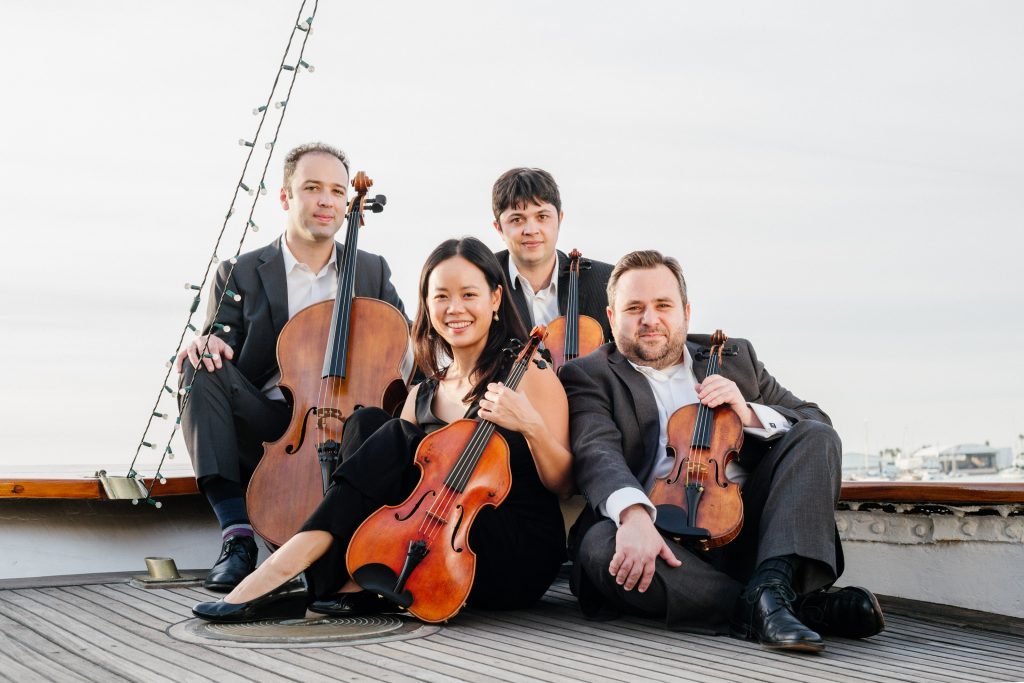Hausmann Quartet Performs Outside on the Deck of the Berkeley on San Diego Bay
The Hausmann Quartet returned to the Maritime Museum of San Diego Sunday afternoon, May 16, bringing its Haydn Voyages series back in front of a live audience, yet another hopeful sign that the restrictions on live performance caused by the COVID pandemic are slowly giving way.

Hausmann Quartet: (from left) Alex Greenbaum, Angela Choong, Isaac Allen, Bram Goldstein [photo (c.) Samantha Zauscher]
Sunday’s program, following Hausmann’s deftly balanced approach since they started their Haydn Voyages series six years ago, featured a pair of Haydn quartets flanking string quartets by 20th-century and contemporary composers: Silvestre Revueltas, Kerwin Young, and Aleksandra Vrebalov.
Young’s “PEace on the Right, JUSTICE on the LEFT” boldly wrenches the rarefied world of classical chamber music into the ranks of social justice demonstrators. The composer has the quartet members speak the rhythmic chant cited in the title while they are playing, even stamping their feet to accent the chant’s cadence. The quotation, attributed to the Rev. Kevin McCall and Terrance Floyd (George Floyd younger brother), was first used at a Minneapolis rally in 2020, and Young employed this chant as a basis for his composition. His web of crisply outlined, driving themes as well as brittle, angular unisons suggest the determination of justice marchers; the work was unusually well-received by the Sunday audience.
Serbian composer Aleksandra Vrebalov’s intriguing, mysterious “My Desert, My Rose,” starts with a hushed, low, meandering cello theme that expands in intensity and tempo as each higher instrument enters and builds on it—perhaps a musical representation of a tight bud opening into full flower.
Silvestre Revueltas, often remembered as a fierce Mexican nationalist composer of the early 20th century, could also turn out edgy modernist works. His Fourth String Quartet, titled Música de Feria, is a splendid example of this style, and Hausmann confidently delivered this austere gem with incisive attacks and bold, aptly aggressive phrasing.
Hearing Haydn’s Quartet No. 44 in E Major, from Op. 54, on the same program with his Quartet No. 17 in F Major, from Op. 17, demonstrated how sophisticated his approach to the genre became. His earlier quartet gives most of the interesting musical ideas to the first violin, an instrument that Haydn played well, while the other three instruments provided little more than harmonic support to the soloist.
In Quartet No 44, however, the composer achieves greater equality among the four voices, and a clear sense of contrapuntal interdependence makes for more engaging textures and progressions. Even in this outdoor setting, Hausmann’s warm sonority and their exquisitely balanced ensemble gave this elegant work its due.
Because Hausmann’s resident musicologist Derek Katz from UC Santa Barbara was not present, members of the quartet—violinists Isaac Allen and Bram Goldstein, violist Angela Choong, and cellist Alex Greenbaum—took turns introducing the works on the program. Each handled their assignment well, and there is something to be said about hearing from the performers’ experience of living with the repertory they bring to the stage.
Perhaps by September 12, 2021, Hausmann’s next Haydn Voyage on the Maritime Museum schedule, these musicians and their loyal followers will be comfortably back inside the Berkeley. We can only hope!

Very interesting and well-performed program. Less ambient noise than The Conrad courtyard.